Study on the Swelling Characteristics of the Offshore Natural Gas Hydrate Reservoir
Abstract
:1. Introduction
2. Experimental Section
2.1. Apparatus and Material
2.2. Experimental Procedure
3. Results and Discussion
3.1. Physical Characteristics of Porous Media
3.2. Swelling Characteristics of Porous Media
3.2.1. Effect of Porous Media Material on the Swelling Characteristics
3.2.2. Effect of Water Content on the Swelling Characteristics
3.2.3. Effect of the Initial Porosity on the Swelling Characteristics
3.2.4. Effect of Salinity on the Swelling Characteristics
3.2.5. The Swelling Characteristics of the Natural Sediments of the Offshore Natural Gas Hydrate Reservoir
3.2.6. A Tentative Exploration on the Influence Mechanism of the Swelling Characteristics of Porous Media on the Structural Characteristics of Reservoir
4. Conclusions
- The swelling of porous media composes the primary swelling stage and the secondary swelling stage. In the primary swelling stage, free water fills the space between particles of porous media and the pores of porous media. In the secondary swelling stage, the bound water is absorbed by porous media. Salt ions mainly affect the swelling of bound water in porous media;
- The swelling rate of porous media is directly proportionate to water content and the initial porosity, and inversely proportionate to salinity. The swelling strain of montmorillonite with the water content of 200 wt% is about twice that of montmorillonite with the water content of 50 wt%. The swelling strain of porous media (montmorillonite) with the initial porosity of 30% is about three times that of montmorillonite with the initial porosity of 60%. The swelling strain of montmorillonite with salinity of 0.2 mol/L is about one and a half times that of montmorillonite with salinity of 1.0 mol/L. Therefore, compared with water content and salinity, the initial porosity has much obvious influence on the swelling;
- The swelling characteristics of the natural sediments are influenced by the coupling of the montmorillonite content and the salt ion concentration;
- The influence mechanism of the swelling characteristics of porous media on the structural characteristics of reservoir can be described as: the swelling force of porous media increases due to the salt dilution effect caused by the hydrate dissociation. The force balance of the reservoirs is broken. Then, the structural characteristics of porous media changes which cause the porous media deformation or the stacking structure change.
Author Contributions
Funding
Institutional Review Board Statement
Data Availability Statement
Conflicts of Interest
References
- Wu, N.; Huang, L.; Hu, G.; Li, Y.; Chen, Q.; Liu, C. Geological controlling factors and scientific challenges for offshore gas hydrate exploitation. Mar. Geol. Qua. Geol. 2017, 37, 1–11. [Google Scholar]
- He, J. The evolving of gas hydrate and the exploration foreground in the north of south China sea. Offshore Oil 2003, 23, 57–64. [Google Scholar]
- Vasheghani Farahani, M.; Hassanpouryouzband, A.; Yang, J.; Tohidi, B. Insights into the climate-driven evolution of gas hydrate-bearing permafrost sediments: Implications for prediction of environmental impacts and security of energy in cold regions. RSC Adv. 2021, 11, 14334–14346. [Google Scholar] [CrossRef]
- Vasheghani Farahani, M.; Hassanpouryouzband, A.; Yang, J.; Tohidi, B. Development of a coupled geophysical–geothermal scheme for quantification of hydrates in gas hydrate-bearing permafrost sediments. Phys. Chem. Chem. Phys. 2021, 23, 24249–24264. [Google Scholar] [CrossRef] [PubMed]
- Waite, W.F.; Santamarina, J.C.; Cortes, D.D.; Dugan, B.; Espinoza, D.N.; Germaine, J.; Jang, J.; Jung, J.W.; Kneafsey, T.J.; Shin, H.; et al. Physical properties of hydrate-bearing sediments. Rev. Geophys. 2009, 47, RG4003:1–RG4003:38. [Google Scholar] [CrossRef]
- Wang, L.; Zhu, Y.; Li, N.; Xu, S.; Tian, Y.; Liu, N.; Wang, W. Formation of permafrost and its influence on natural gas hydrate accumulation in Muli Region, Qinghai Province. Coal Geol. Explor. 2022, 50, 121–129. [Google Scholar]
- Konno, Y.; Fujii, T.; Sato, A.; Akamine, K.; Naiki, M.; Masuda, Y.; Yamamoto, K.; Nagao, J. Key Findings of the World’s First Offshore Methane Hydrate Production Test off the Coast of Japan: Toward Future Commercial Production. Energy Fuels 2017, 31, 2607–2616. [Google Scholar] [CrossRef]
- Zhang, W.; Liang, J.; Wei, J.; Lu, J.a.; Su, P.; Lin, L.; Huang, W.; Guo, Y.; Deng, W.; Yang, X.; et al. Geological and geophysical features of and controls on occurrence and accumulation of gas hydrates in the first offshore gas-hydrate production test region in the Shenhu area, Northern South China Sea. Mar. Petrol. Geol. 2020, 114, 104191. [Google Scholar] [CrossRef]
- Schanz, T.; Al-Badran, Y. Swelling pressure characteristics of compacted Chinese Gaomiaozi bentonite GMZ01. Soils Found. 2014, 54, 748–759. [Google Scholar] [CrossRef]
- Sun, D.; Sun, W.; Fang, L. Swelling characteristics of Gaomiaozi bentonite and its prediction. J. Rock Mech. Geotech. Eng. 2014, 6, 113–118. [Google Scholar] [CrossRef]
- Xu, Y.; Xiang, G.; Jiang, H.; Chen, T.; Chu, F. Role of osmotic suction in volume change of clays in salt solution. Appl. Clay Sci. 2014, 101, 354–361. [Google Scholar] [CrossRef]
- Wu, Z.; Liu, W.; Zheng, J.; Li, Y. Effect of methane hydrate dissociation and reformation on the permeability of clayey sediments. Appl. Energy 2020, 261, 114479. [Google Scholar] [CrossRef]
- Wu, Z.; Li, Y.; Sun, X.; Wu, P.; Zheng, J. Experimental study on the effect of methane hydrate decomposition on gas phase permeability of clayey sediments. Appl. Energy 2018, 230, 1304–1310. [Google Scholar] [CrossRef]
- Wang, Y.; Yang, Y.; Wang, K.; Tao, L.; Liu, J.; Wang, C.; Yao, J.; Zhang, K.; Song, W. Changes in relative permeability curves for natural gas hydrate decomposition due to particle migration. J. Nat. Gas Sci. Eng. 2020, 84, 103634. [Google Scholar] [CrossRef]
- Wang, Y.; Feng, J.C.; Li, X.S.; Zhang, Y.; Han, H. Methane hydrate decomposition and sediment deformation in unconfined sediment with different types of concentrated hydrate accumulations by innovative experimental system. Appl. Energy 2018, 226, 916–923. [Google Scholar] [CrossRef]
- Wang, Y.; Zhan, L.; Feng, J.C.; Li, X.S. Influence of the Particle Size of Sandy Sediments on Heat and Mass Transfer Characteristics during Methane Hydrate Dissociation by Thermal Stimulation. Energies 2019, 12, 4227. [Google Scholar] [CrossRef]
- Xiang, G.S.; Xu, Y.F.; Jiang, H. Surface fractal dimension of bentonite and its application in calculation of swelling deformation. Surf. Rev. Lett. 2014, 21, 1450074. [Google Scholar] [CrossRef]
- Li, J.; Lu, J.; Kang, D.; Ning, F.; Lu, H.; Kuang, Z.; Wang, D.; Liu, C.; Hu, G.; Wang, J.; et al. Lithological characteristics and hydrocarbon gas sources of gas hydrate-bearing sediments in the Shenhu area, South China Sea: Implications from the W01B and W02B sites. Mar. Geol. 2019, 408, 36–47. [Google Scholar] [CrossRef]
- Shen, P.F.; Li, X.S.; Li, G. Gas permeability and shape factor of natural sediments in the South China Sea. J. Nat. Gas Sci. Eng. 2020, 83, 103626. [Google Scholar] [CrossRef]
- Xu, Y.F.; Matsuoka, H.; Sun, D.A. Swelling characteristics of fractal-textured bentonite and its mixtures. Appl. Clay Sci. 2003, 22, 197–209. [Google Scholar] [CrossRef]
- Li, Z.; Tang, C.; Hu, R.; Zhou, Y. Experimental research on expansion characteristics of Mengzi expansive soil with water, salt and acid immersion. Environ. Earth Sci. 2013, 72, 363–371. [Google Scholar] [CrossRef]
- Xu, Y. Hydraulic mechanism and swelling deformation theory of expansive soils. Chin. J. Geotech. Eng. 2020, 42, 1979–1987. [Google Scholar]
- Xu, J.; Du, S.; Hao, Y.; Yang, X.; Zhang, J. Molecular simulation study of methane hydrate formation mechanism in NaCl solutions with different concentrations. Chem. Phys. 2021, 551, 111323. [Google Scholar] [CrossRef]
- Li, S.; Wang, J.; Lv, X.; Ge, K.; Jiang, Z.; Li, Y. Experimental measurement and thermodynamic modeling of methane hydrate phase equilibria in the presence of chloride salts. Chem. Eng. J. 2020, 395, 125126. [Google Scholar] [CrossRef]
- Xiang, G.; Xu, Y.; Yu, F.; Fang, Y.; Wang, Y. Prediction of swelling characteristics of compacted GMZ bentonite in salt solution incorporating ion-exchange reactions. Clay Clay Miner. 2019, 67, 163–172. [Google Scholar] [CrossRef]
- Tanikawa, W.; Hirose, T.; Hamada, Y.; Gupta, L.P.; Ahagon, N.; Masaki, Y.; Abe, N.; Wu, H.Y.; Sugihara, T.; Nomura, S.; et al. Porosity, permeability, and grain size of sediment cores from gas-hydrate-bearing sites and their implication for. overpressure in shallow argillaceous formations: Results from the national gas hydrate program expedition 02, Krishna-Godavari Basin, India. Mar. Petrol. Geol. 2019, 108, 332–347. [Google Scholar] [CrossRef]
- Portnov, A.; Cook, A.E.; Heidari, M.; Sawyer, D.E.; Santra, M.; Nikolinakou, M. Salt-driven evolution of a gas hydrate reservoir in Green Canyon, Gulf of Mexico. Aapg. Bull. 2020, 104, 1903–1919. [Google Scholar] [CrossRef]
- Wang, Y.; Pan, M.; Mayanna, S.; Schleicher, A.M.; Spangenberg, E.; Schicks, J.M. Reservoir formation damage during hydrate dissociation in sand-clay sediment from Qilian Mountain permafrost, China. Appl. Energy 2020, 263, 114619. [Google Scholar] [CrossRef]
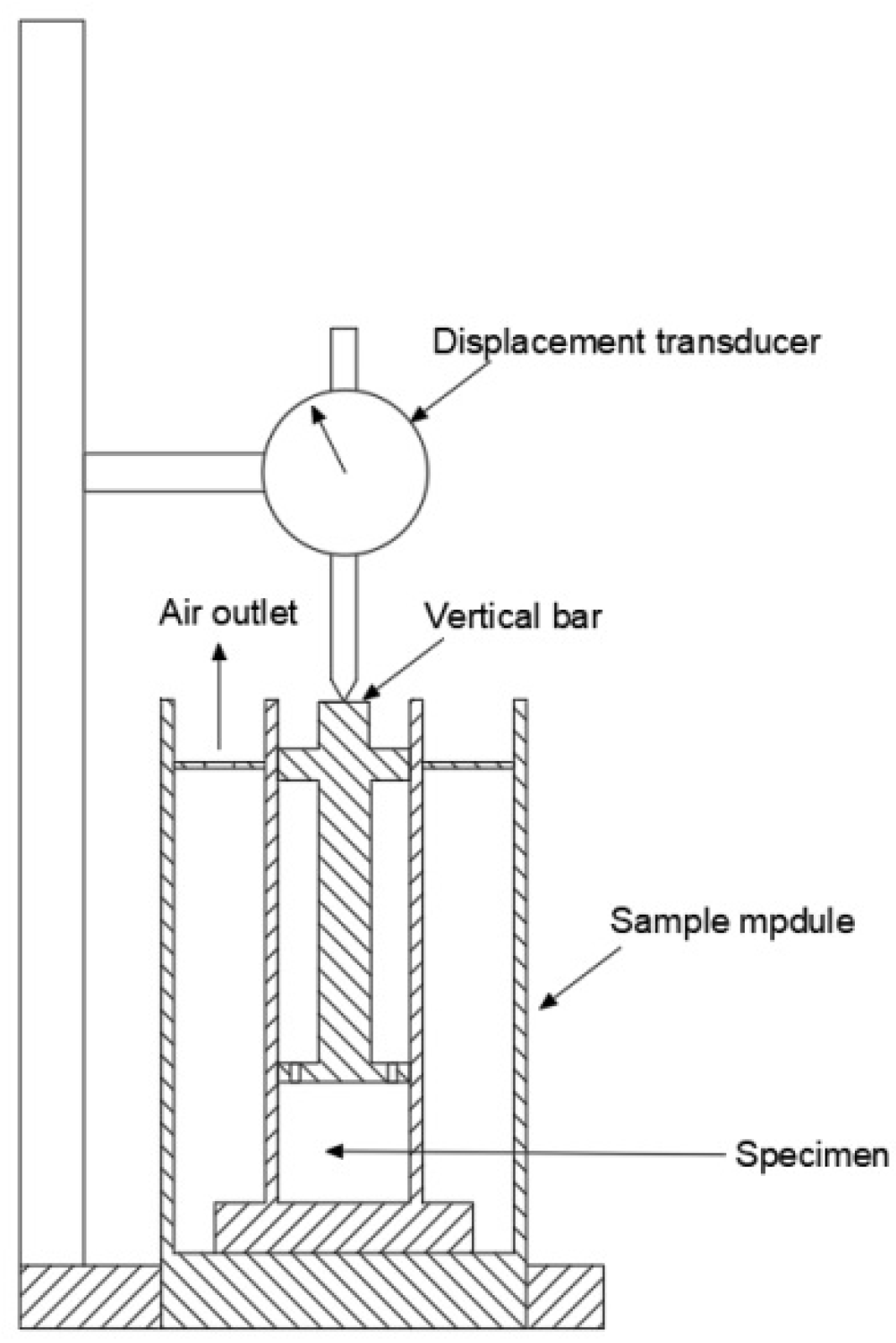
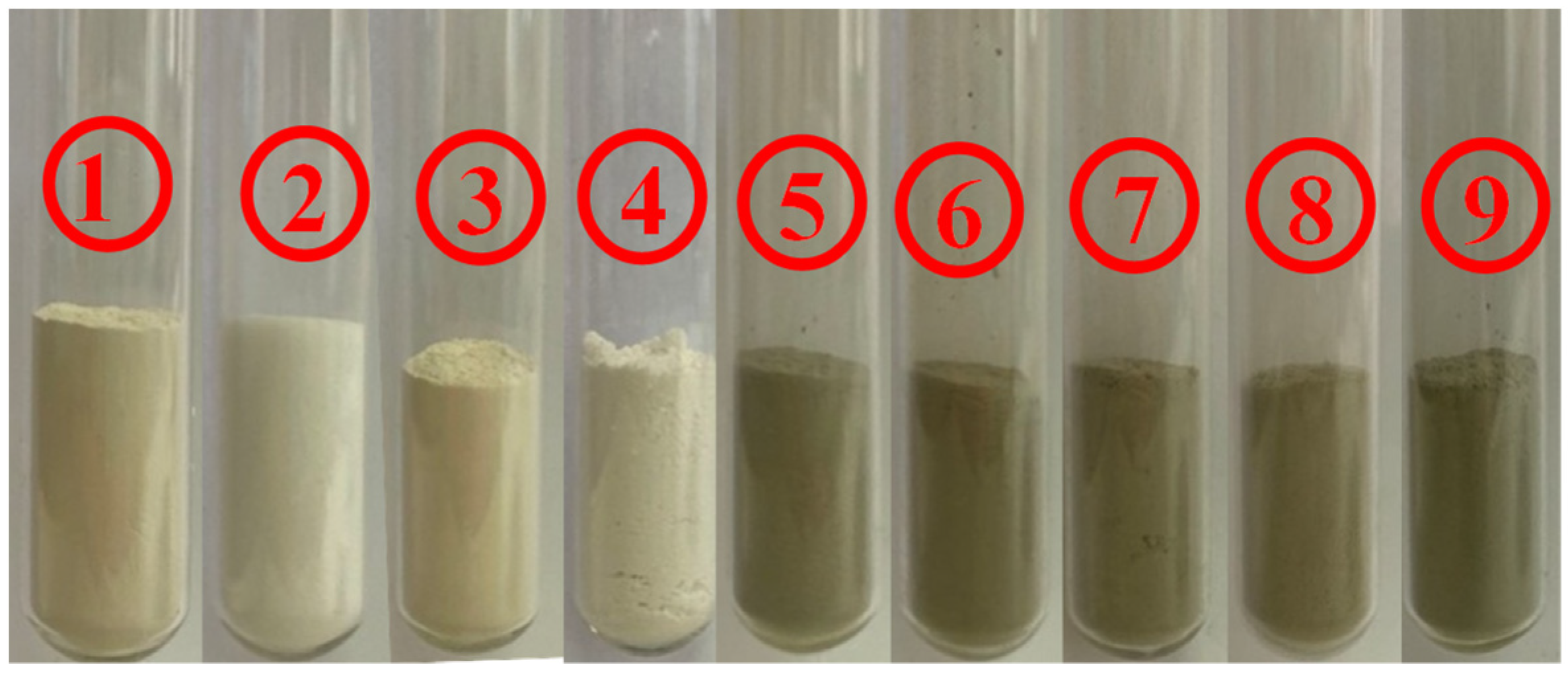

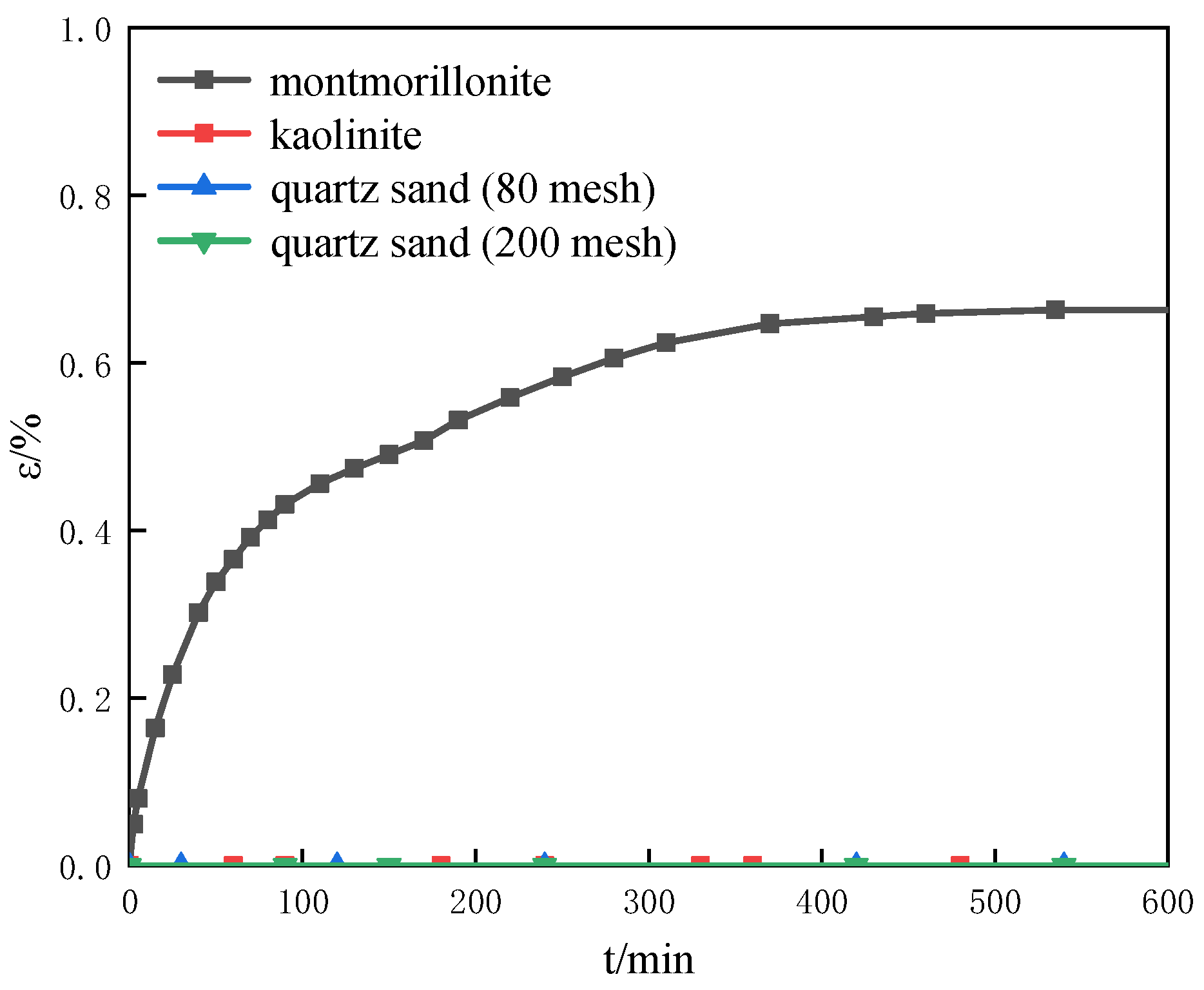
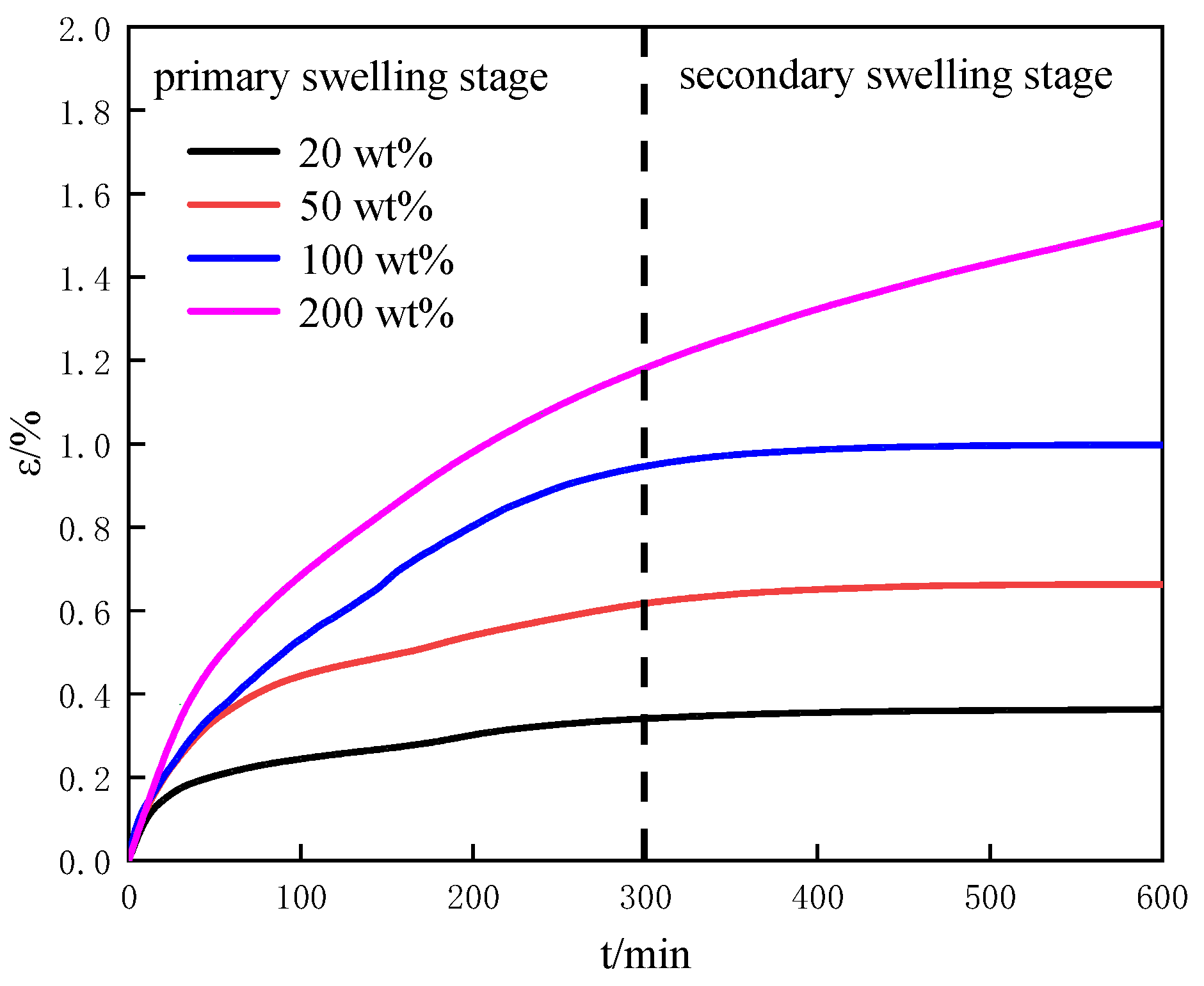



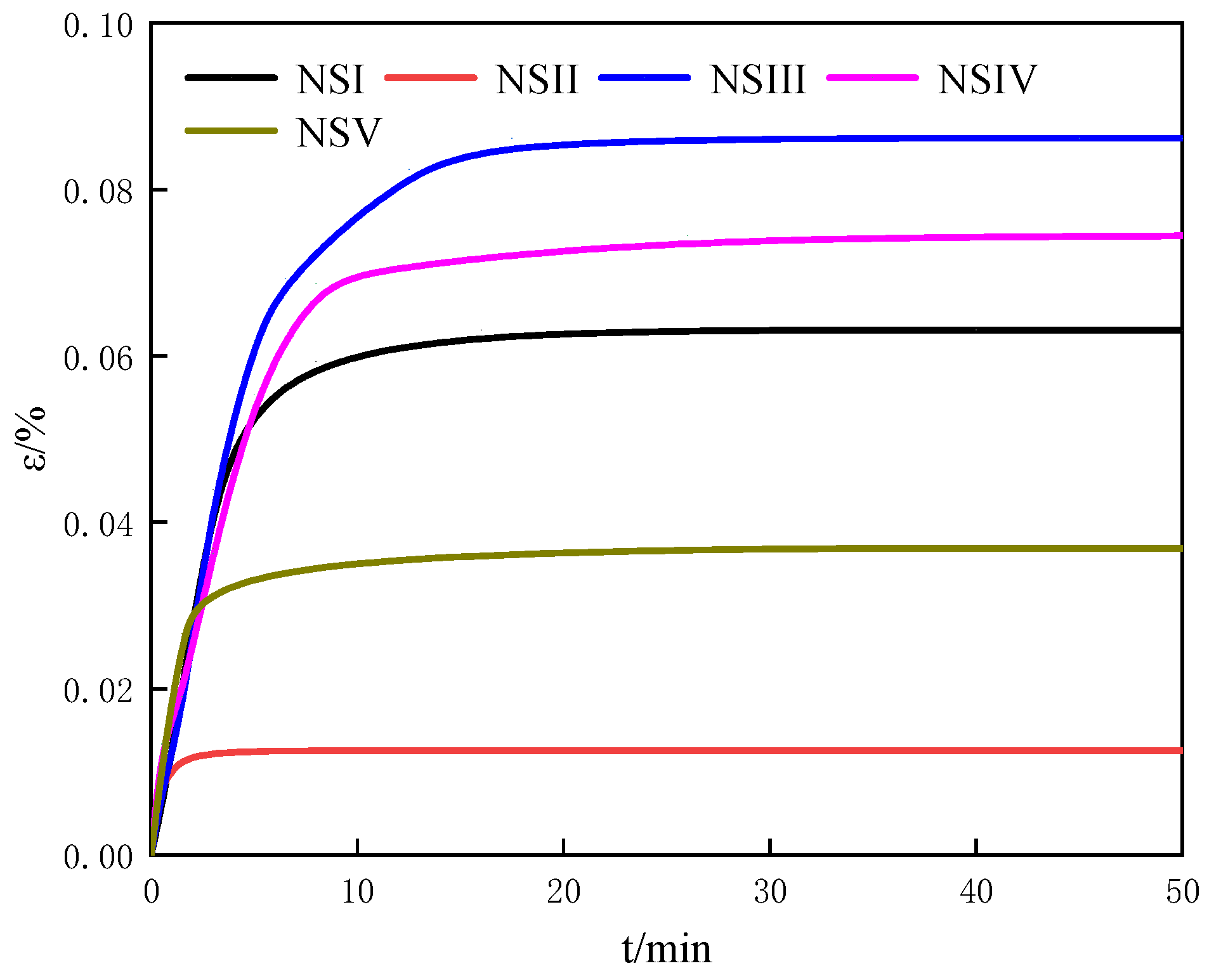

| Serial Number | Porous Media | Sources | Depths/m |
|---|---|---|---|
| 1 | montmorillonite | NANOCOR Company, Arlington Heights, IL, USA | — |
| 2 | quartz sand (80 mesh) | Shanghai McLean Biochemical Technology Co., Ltd., Shanghai, China | — |
| 3 | quartz sand (200 mesh) | Shanghai McLean Biochemical Technology Co., Ltd., Shanghai, China | — |
| 4 | kaolinite | Shanghai Aladdin Biochemical Technology Co., Ltd., Shanghai, China | — |
| 5 | NSI | Qiong Dongnan Basin | 3600 |
| 6 | NSII | East China Sea | 959 |
| 7 | NSIII | Shenhu Area of South China Sea | 1070 |
| 8 | NSIV | Shenhu Area of South China Sea | 1400 |
| 9 | NSV | Shenhu Area of South China Sea | 3415 |
| Factors | Parameters | |||
|---|---|---|---|---|
| salinity/(mol·L−1) | 0.0 | 0.2 | 0.5 | 1 |
| water content/wt% | 20 | 50 | 100 | 200 |
| porosity/% | 20 | 30 | 40 | 50 |
| Components | NSI/% | NSII/% | NSIII/% | NSIV/% | NSV/% | Montmorillonite/% | Quartz Sand/% |
|---|---|---|---|---|---|---|---|
| SiO2 | 29.69 | 50.11 | 49.13 | 42.85 | 51.90 | 55.26 | 99.20 |
| CaO | 17.55 | 13.36 | 15.47 | 19.32 | 8.35 | 0.42 | 0.01 |
| Al2O3 | 10.50 | 15.10 | 13.86 | 13.5 | 17.13 | 19.32 | 0.52 |
| Fe2O3 | 3.37 | 5.60 | 5.50 | 5.34 | 7.20 | 1.84 | 0.05 |
| MgO | 2.54 | 2.73 | 2.27 | 2.27 | 2.90 | 3.03 | 0.03 |
| K2O | 1.48 | 2.77 | 2.35 | 2.23 | 2.90 | 0.22 | 0.08 |
| Na2O | 1.00 | 1.68 | 1.39 | 1.57 | 1.96 | 3.63 | 0.00 |
| SO3 | 0.72 | 0.52 | 0.24 | 0.29 | 0.53 | 0.37 | 0.00 |
| P2O5 | 0.10 | 0.17 | 0.17 | 0.13 | 0.12 | 0.02 | 0.01 |
| MnO | 0.05 | 0.06 | 0.09 | 0.34 | 0.12 | 0.01 | 0.00 |
| TiO2 | 0.45 | 0.80 | 0.77 | 0.68 | 0.81 | 0.00 | 0.02 |
| O | 31.49 | 5.33 | 7.87 | 9.97 | 3.91 | 15.43 | 0.08 |
| Cl | 0.90 | 1.61 | 0.68 | 1.35 | 2.01 | 0.13 | 0.00 |
| Physical Properties | NSI | NSII | NSIII | NSIV | NSV | Montmorillonite | Quartz Sand (80 mesh) | Quartz Sand (200 mesh) | Kaolinite |
|---|---|---|---|---|---|---|---|---|---|
| Mean particle size/μm | 9.9 | 37.8 | 6.4 | 3.2 | 52.4 | 17.4 | 262.9 | 32.6 | 8.5 |
| Density/(g/cc) | 2.1 | 2.0 | 2.4 | 2.5 | 1.9 | 2.3 | 2.1 | 2.5 | 2.4 |
| D | 2.49 | 2.50 | 2.50 | 2.53 | 2.57 | 2.40 | 2.33 | 2.31 | 2.51 |
Disclaimer/Publisher’s Note: The statements, opinions and data contained in all publications are solely those of the individual author(s) and contributor(s) and not of MDPI and/or the editor(s). MDPI and/or the editor(s) disclaim responsibility for any injury to people or property resulting from any ideas, methods, instructions or products referred to in the content. |
© 2023 by the authors. Licensee MDPI, Basel, Switzerland. This article is an open access article distributed under the terms and conditions of the Creative Commons Attribution (CC BY) license (https://creativecommons.org/licenses/by/4.0/).
Share and Cite
Yan, K.; Zhao, J.; Li, X.; Feng, J.; Xia, Z.; Ruan, X. Study on the Swelling Characteristics of the Offshore Natural Gas Hydrate Reservoir. Entropy 2023, 25, 278. https://doi.org/10.3390/e25020278
Yan K, Zhao J, Li X, Feng J, Xia Z, Ruan X. Study on the Swelling Characteristics of the Offshore Natural Gas Hydrate Reservoir. Entropy. 2023; 25(2):278. https://doi.org/10.3390/e25020278
Chicago/Turabian StyleYan, Kefeng, Jianyu Zhao, Xiaosen Li, Jingchun Feng, Zhiming Xia, and Xuke Ruan. 2023. "Study on the Swelling Characteristics of the Offshore Natural Gas Hydrate Reservoir" Entropy 25, no. 2: 278. https://doi.org/10.3390/e25020278




